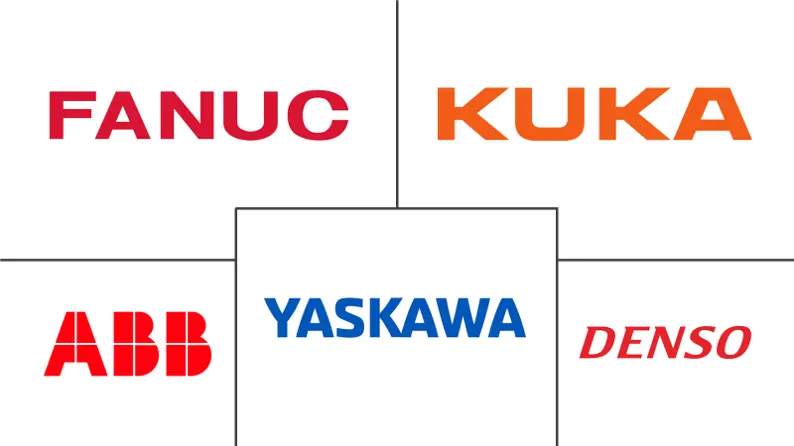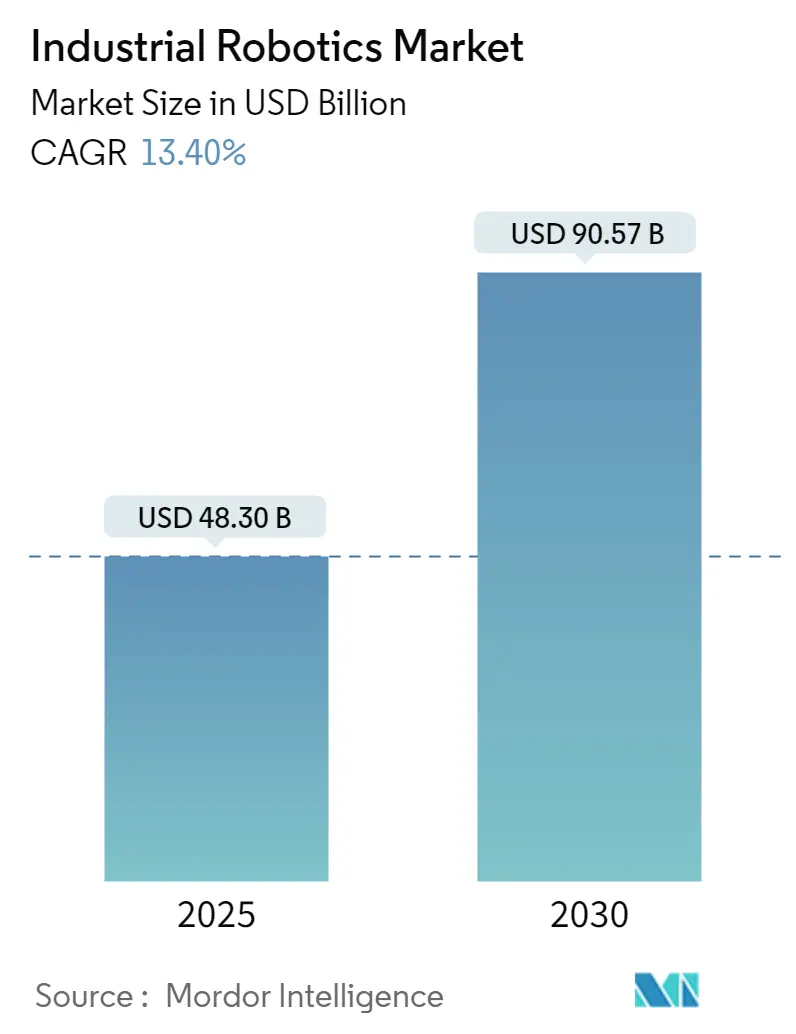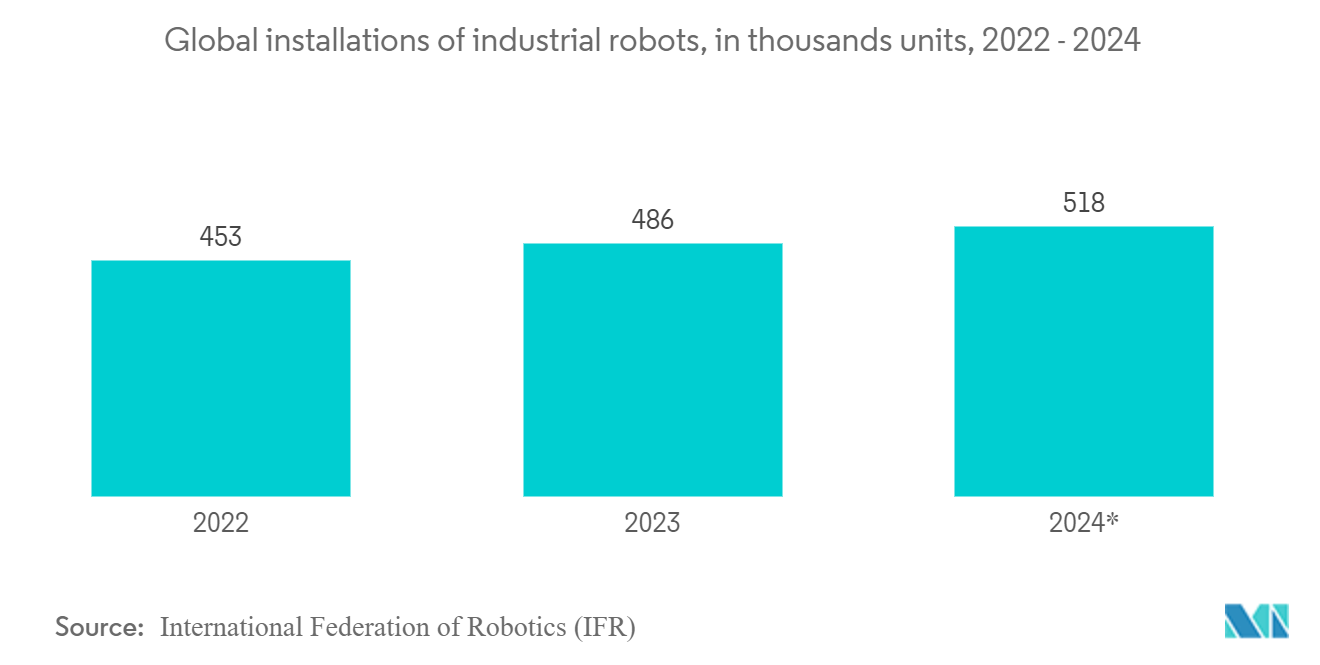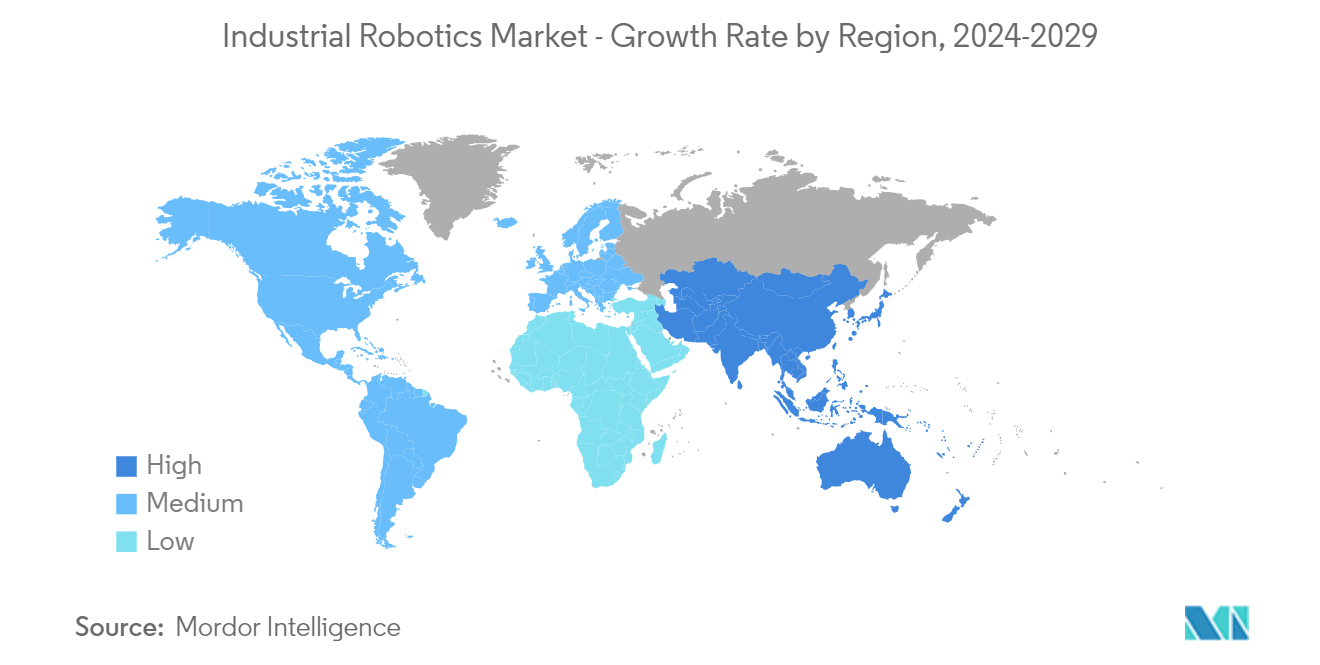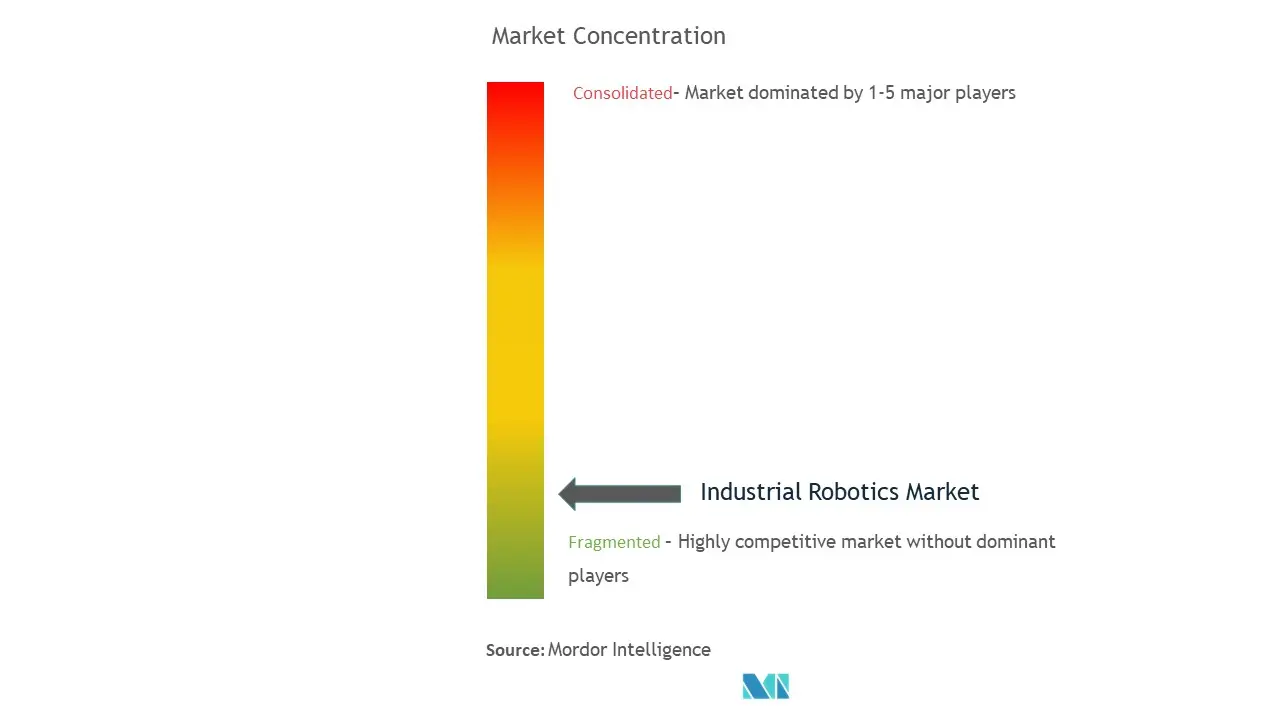Industrial Robotics Market Analysis
The Industrial Robotics Market size is estimated at USD 48.30 billion in 2025, and is expected to reach USD 90.57 billion by 2030, at a CAGR of 13.4% during the forecast period (2025-2030).
- Industrial robots play a crucial role in manufacturing industrial automation, with many core operations in industries being managed by robots. With economic growth across regions, e-commerce, electronics, and the automotive industry, among others, have increased.
- Rising penetration of the IoT and investments in robotics across regions have been major contributors to the market's growth. For instance, the 'Made in China 2025' announcement aimed to broadly upgrade the Chinese industry by moving toward quality-focused and innovation-driven manufacturing.
- Industry 4.0, the newest industrial revolution, has fueled the development of new technologies, like collaborative robots, AI-enabled robots, etc., and has enabled industries to use robots to streamline many processes, increase efficiency, and eliminate errors. Increased workplace safety and improved production capabilities have further driven industries to invest in robotic systems.
- Owing to collaborative robots, which are estimated to account for 34% of the total robot sales in 2025 (according to the International Federation of Robots (IFR), the penetration of industrial robots is expected to rise across industries, such as plastics, food and consumer goods, semiconductors and electronics, life sciences, and pharmaceuticals. Another notable factory automation is expected at Apple's factories through Foxconn's robots. Semiconductor industry IC foundries have been among the adopters that have impacted the current market demands.
- Some of the major factors driving the market include rising demand for high-quality products (which need proper end-to-end visibility in the manufacturing process), the need for energy conservation, and rising focus on workplace safety. Incremental advancements in technology, coupled with a sustained increase in the development of manufacturing facilities, are also expected to drive this market, for instance, According to the Association for Advancing Automation (A3), which monitors industrial robot sales in North America. Companies ordered 44,196 robots in 2022, 11% more than in 2021.
Industrial Robotics Market Trends
Automotive Industry to Hold Major Share
- For the past 50 years, the automotive industry has used robots in its assembly lines for various manufacturing processes. Currently, automakers are exploring the use of robotics in more procedures. Robots are more efficient, flexible, accurate, and dependable for such production lines. This technology enables the automotive industry to remain one of the most significant robot users and possess one of the most automated supply chains globally.
- Furthermore, the growing adoption of automation in the automotive manufacturing process and the involvement of AI and digitalization are the primary factors increasing the demand for industrial robots in the automotive sector.
- In today's automotive industry, the advancement of robotics technology has accelerated to keep up with the rapid changes in the automotive industry. A robotics solution simulation and virtual commissioning will utilize the maximum benefits of factory automation for OEMs, startups, and suppliers in the present automotive industry.
- For instance, For instance, Europe's second-largest car manufacturer, PSA Group, modernizes its European manufacturing sites with Universal Robots' UR10 collaborative robots. According to UBS, around 6.3 billion electric vehicles are forecast to be sold in Europe in 2025.
- To cater to the changing landscape of automotive manufacturing, many players in the industry are adopting industrial robots. For instance, in January 2022, Huayu Automotive Systems Co., which does business as HASCO, and ABB Group announced that they have created a joint venture building on their existing relationship "to drive the next generation of smart manufacturing." The companies claimed that the joint venture would enable them to further develop HASCO's leading position with automated solutions that benefit customers in China.
- Further, the growing automotive sector worldwide supports the growth of industrial robotics for welding car parts, palletizing, part insertion, pick-and-pale applications, and many other uses. Moreover, in July 2022, Yamaha Motor Robotics announced to showcase of its latest robots for Advanced Automation at Motek 2022. The company will demonstrate SCARA, cartesian and single-axis robots, and the LCMR200 linear conveyor module, highlighting their speed, accuracy, and flexibility.
North America to Hold a Significant Market Share
- The government in the region is also encouraging the adoption of robotics by taking initiatives to support the development of modern technologies in the robotics market. For instance, the US federal government has commenced the National Robotics Initiative (NRI) program to bolster the capabilities of building domestic robots and encourage research activities in the field.
- In February 2022, United States Steel and Carnegie Foundry, a robotics and AI studio, announced a strategic investment and relationship. The two Pittsburgh-based startups will collaborate to accelerate and expand industrial automation powered by advanced robotics and artificial intelligence. Carnegie Foundry will use this funding to market and scale its industrial automation portfolio of robotics and AI technologies in advanced manufacturing, industrial robots, integrated systems, autonomous mobility, speech analytics, and other areas.
- In March 2022, Kinova Robotics introduced Link 6, Canada's first industrial collaborative robot. Link 6 is Canada's first industrial collaborative robot, with automation solutions that increase daily productivity while enhancing product quality and consistency. The Link 6 robotic arm is developed and constructed with any user in mind, both for experienced industrial integrators and operators with no particular robotic expertise, achieving quick cycle times through longer reach and fast movements. The Link 6 controller from Kinova has the market's most processing power and memory capacity. It supports an optional GPU, making it ready for use with future AI solutions while keeping the controller compact.
- Association for Advancing Automation (A3), companies in North America ordered 9,853 million robots in the second quarter of 2021, which is a significant increase compared to 2020, with 5,196 sales, leading to new job opportunities. Further, according to Robotic Industries Association (RIA), the most critical driver of the year-to-date increase in industrial robots was an 83% growth in units purchased by automotive OEMs for process automation.
Industrial Robotics Industry Overview
The industrial robotics market is highly fragmented. Industry 4.0, with digitalization initiatives across regions, provides lucrative opportunities in the industrial robots market. The degree of transparency is high, considering the number of robotic trade exhibits across conducted areas occasionally. Overall, the competitive rivalry among existing players is high. The acquisitions and collaboration of large companies with startups are predicted, focusing on innovation. A few major players in the market are ABB and Yaskawa. Some of the key developments in the area are:
- May 2024: ABB, an industrial robot manufacturer, unveiled its latest modular large robots at Automate 2024. These robot arms, in conjunction with the previously released IRB 5710-5720 and IRB 6710-6740 models, now present a lineup of 46 variants. These variants are capable of managing payloads ranging from 70 to 620 kilograms (approximately 150 to 1,350 pounds).
- March 2024: Mobile Industrial Robots has unveiled its latest product, the MiR1200 autonomous pallet jack. Equipped with advanced 3D vision technology, the MiR1200 Pallet Jack is designed to streamline labor-intensive materials handling. This robot can adapt its route dynamically, ensuring navigation even in the presence of obstacles, such as loose objects on the floor or overhead hindrances.
Industrial Robotics Market Leaders
-
ABB Ltd.
-
Yaskawa Electric Corporation
-
Denso Corporation
-
Fanuc Corporation
-
KUKA AG
- *Disclaimer: Major Players sorted in no particular order
Industrial Robotics Market News
- May 2024: Comau has launched its new S-Family of small yet powerful robots. Known for their precise performance and iconic red design, they also demonstrate Comau’s commitment to making automation more accessible to various non-automotive industries.
- April 2024: Pudu Technology Co. launched the PUDU T300, expanding its reach into industrial applications. The T300 complies with ISO 3691-4 industrial safety standards and features lidar, a depth camera, collision-protection edges, and emergency stop buttons. Additionally, the T300 offers automatic recharging in about two hours and quick battery-swapping capabilities, ensuring continuous 24/7 operation to meet various customer requirements.
Industrial Robotics Industry Segmentation
An industrial robot is a robot system used for manufacturing. Industrial robots are automated, programmable, and capable of movement on three or more axis. Industrial robots are used in multiple industries and applications. The elimination of labor-intensive activities is driving the Industrial robotics market.
The industrial robotics market is segmented by type of robot (articulated robots, linear robots, cylindrical robots, parallel robots, SCARA Robots), end-user industry (automotive, chemical, and manufacturing, construction, electrical and electronics, food and beverage, machinery and metal, pharmaceutical), and Geography Europe (United Kingdom, Germany, France, rest of Europe), Asia Pacific (Japan, China, India, South Korea, and Rest of Asia Pacific), Latin America, Middle East and Africa. The market sizes and forecasts are provided in terms of value (USD) for all the above segments.
| By Type of Robot | Articulated Robots | ||
| Linear Robots | |||
| Cylindrical Robots | |||
| Parallel Robots | |||
| SCARA Robots | |||
| Other Types of Robot | |||
| By End-user Industry | Automotive | ||
| Chemical and Manufacturing | |||
| Construction | |||
| Electrical and Electronics | |||
| Food and Beverage | |||
| Machinery and Metal | |||
| Pharmaceutical | |||
| Other End-user Industries (Rubber, Optics) | |||
| By Geography*** | North America | United States | |
| Canada | |||
| Europe | United Kingdom | ||
| France | |||
| Germany | |||
| Asia | Japan | ||
| China | |||
| India | |||
| South Korea | |||
| Australia and New Zealand | |||
| Latin America | |||
| Middle East and Africa | |||
Industrial Robotics Market Research FAQs
How big is the Industrial Robotics Market?
The Industrial Robotics Market size is expected to reach USD 48.30 billion in 2025 and grow at a CAGR of 13.40% to reach USD 90.57 billion by 2030.
What is the current Industrial Robotics Market size?
In 2025, the Industrial Robotics Market size is expected to reach USD 48.30 billion.
Who are the key players in Industrial Robotics Market?
ABB Ltd., Yaskawa Electric Corporation, Denso Corporation, Fanuc Corporation and KUKA AG are the major companies operating in the Industrial Robotics Market.
Which is the fastest growing region in Industrial Robotics Market?
Asia Pacific is estimated to grow at the highest CAGR over the forecast period (2025-2030).
Which region has the biggest share in Industrial Robotics Market?
In 2025, the North America accounts for the largest market share in Industrial Robotics Market.
What years does this Industrial Robotics Market cover, and what was the market size in 2024?
In 2024, the Industrial Robotics Market size was estimated at USD 41.83 billion. The report covers the Industrial Robotics Market historical market size for years: 2019, 2020, 2021, 2022, 2023 and 2024. The report also forecasts the Industrial Robotics Market size for years: 2025, 2026, 2027, 2028, 2029 and 2030.
Our Best Selling Reports
Industrial Robots Industry Report
The industrial robotics and automation sector is experiencing significant growth, driven by Industry 4.0 technologies and an increasing demand for collaborative robots across various industries. This surge is characterized by the integration of AI-enabled robots, which enhance productivity and reduce errors, particularly in sectors such as automotive and pharmaceuticals where precision is critical. The push towards automation is motivated by the need for quality, energy efficiency, and safety. Investments in robotics and IoT are propelling market growth, with articulated robots and handling applications leading the way.
North America and Asia Pacific are at the forefront of this growth, supported by government initiatives and a thriving electronics industry. As the market evolves, it presents new opportunities for efficiency in diverse sectors. For those seeking detailed insights, Mordor Intelligence™ offers an extensive analysis of the industrial robots market, including market size, market share, and market trends. The free report PDF download provides a comprehensive overview of the market, covering various segments and geographical regions.
The market analysis indicates that the industrial robots market is poised for continued expansion, driven by technological advancements and increasing adoption across different industries. The report also highlights the significant role of industry research and industry reports in understanding market dynamics. With a focus on market data, market forecast, and market segmentation, the report provides valuable information for stakeholders.
Industry statistics reveal that the market value and market growth are influenced by factors such as government support and the adoption of AI-enabled robots. The market review and market outlook sections of the report offer insights into future trends and predictions. Industry analysis and industry trends are crucial for understanding the evolving landscape of the industrial robotics market. The report example and report PDF serve as essential resources for those looking to delve deeper into the market.
In summary, the industrial robots market is set to grow, with articulated robots playing a significant role. The market leaders are leveraging technological advancements to stay ahead. The industry outlook remains positive, with market predictions indicating sustained growth. The market overview and market segmentation provide a clear understanding of the market dynamics. For a detailed analysis, the report offers comprehensive industry information and industry sales data, making it an invaluable resource for stakeholders.

